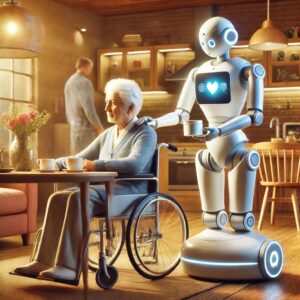The global long-term care (LTC) market is poised for substantial growth in the coming years, driven by the increasing aging population, rising prevalence of chronic diseases, and the growing demand for quality care services. Valued at approximately $1.74 trillion by 2030, with a compound annual growth rate (CAGR) of 6.68% from 2024 to 2030, the LTC market presents significant opportunities for innovations aimed at enhancing the quality of life for the elderly (Research & Markets) (Grand View Research).
Key Drivers of Market Growth
- Aging Population: The world is witnessing an unprecedented increase in the number of elderly individuals, particularly in developed regions such as North America, Europe, and Asia-Pacific. This demographic shift is leading to a surge in demand for long-term care services.

- Chronic Diseases: Conditions such as Alzheimer’s, dementia, and other age-related illnesses are becoming more prevalent, necessitating specialized care services that can cater to these complex health needs.
- Technological Advancements: The adoption of advanced technologies, including telehealth, artificial intelligence (AI), and robotics, is revolutionizing the LTC industry, making care more efficient, effective, and accessible.
The Role of Caregiver Robots
Caregiver robots are set to play a pivotal role in transforming the LTC landscape. These robots are designed to assist with a variety of tasks, improving the quality of life for the elderly and alleviating the burden on human caregivers. Here are some of the key benefits and applications of caregiver robots:
- Physical Assistance: Robots like ROSE, which I have invented, provide physical support to the elderly, helping them with mobility, transfers, and other daily activities. This reduces the risk of falls and injuries, promoting independence and safety.
- Routine Tasks: Robots can handle routine tasks such as medication dispensing, monitoring vital signs, and even assisting with personal hygiene. This ensures timely and accurate administration of care, which is crucial for managing chronic conditions.
- Companionship and Emotional Support: Advanced robots equipped with AI and natural language processing can engage in conversations, providing companionship and emotional support to the elderly. This helps combat loneliness and enhances mental well-being.
- Care Coordination: By integrating with healthcare systems, caregiver robots can facilitate better care coordination, ensuring that all stakeholders, including family members, caregivers, and healthcare providers, are well-informed and aligned in their efforts.
Enhancing Quality of Life
The integration of robots in LTC not only enhances the efficiency of care delivery but also significantly improves the quality of life for the elderly. By taking over physically demanding and routine tasks, robots free up human caregivers to focus on more complex and personal aspects of care. This holistic approach ensures that the elderly receive comprehensive support that addresses both their physical and emotional needs.
The Future Outlook
As the global LTC market continues to grow, the adoption of caregiver robots and other advanced technologies will become increasingly important. Governments and private sectors alike are recognizing the potential of these innovations to address the impending caregiver shortage and the rising demand for quality care services.
In conclusion, the future of long-term care is bright, with caregiver robots set to play a crucial role in enhancing the quality of life for the elderly. As we continue to develop and integrate these technologies, we move closer to a world where aging with dignity and independence is a reality for everyone.

